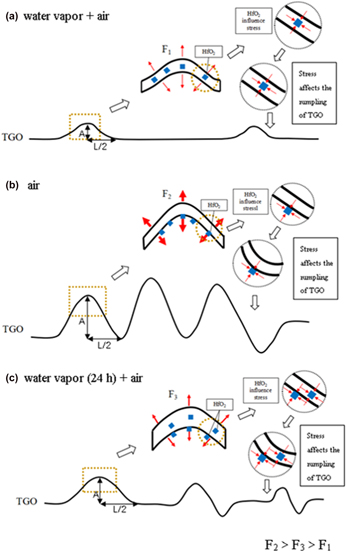Crossref Citations
This article has been cited by the following publications. This list is generated based on data provided by
Crossref.
Lü, Kaiyue
Yuan, Xiaohu
Li, Dingjun
Lü, Jianguo
Song, Peng
Li, Qiaolei
Li, Chao
Huang, Taihong
Chen, Rong
Zheng, Biju
and
Lu, Jiansheng
2019.
Cyclic oxidation behaviour of Pt-doped aluminide coating on DZ125 containing Hf.
Materials Research Express,
Vol. 6,
Issue. 12,
p.
126536.
Wei, Zhi-Yuan
and
Cai, Hong-Neng
2020.
Comprehensive effects of TGO growth on the stress characteristic and delamination mechanism in lamellar structured thermal barrier coatings.
Ceramics International,
Vol. 46,
Issue. 2,
p.
2220.
Huang, Wenlang
Huang, Taihong
Song, Peng
Chen, Rong
Zheng, Biju
Wang, Chengxi
Li, Chao
and
Lu, Jiansheng
2021.
CrO2(OH)2 volatilization rate and oxidation behavior prediction of the NiCr coating in air-H2O environment at 650 ℃.
Corrosion Science,
Vol. 182,
Issue. ,
p.
109303.
Zhai, Ruixiong
Song, Peng
Huang, Taihong
Li, Chao
Hua, Chen
Huang, Wenlang
Li, Qing
Zheng, Biju
and
Lu, Jiansheng
2021.
Microstructure and oxidation behaviour of MoSi2 coating combined MoB diffusion barrier layer on Mo substrate at 1300 °C.
Ceramics International,
Vol. 47,
Issue. 7,
p.
10137.
He, Yang
Zheng, Biju
Song, Peng
Huang, Taihong
Pei, Hezhong
Yang, Bixiao
and
Shakeel, Shakeel
2022.
Effects of Stepped Heating on the Initial Growth of Oxide Scales on NiCrAlHf Bond Coat Alloy under Air and Water Vapor Atmospheres.
Materials,
Vol. 15,
Issue. 8,
p.
2914.
Li, Shuai
Di, Yuelan
Wang, Haidou
Zhao, Yuncai
Wang, Li
and
Dong, Lihong
2022.
Structural characteristics and high-temperature oxidation behaviour of nano-HfO2-doped thermal barrier coatings.
Ceramics International,
Vol. 48,
Issue. 4,
p.
5229.
He, Yang
Song, Peng
Pei, Hezhong
and
Huang, Taihong
2022.
Influence of Hf and Si on the Sulphur Diffusion Behavior of Mcraly Coatings on a Ni-Based Single Crystal Super Alloy.
SSRN Electronic Journal ,
Zhang, Shilei
Li, Shuai
Zhao, Yuncai
Wang, Ximao
and
Liu, Cunyu
2023.
Effect of Rare Earth Doping on the Tensile Properties of High Temperature Oxidation Coating.
Journal of Wuhan University of Technology-Mater. Sci. Ed.,
Vol. 38,
Issue. 6,
p.
1449.
Huang, Yan
He, Yang
Yang, Bixiao
Khan, Asim
Zhao, Xinyu
and
Song, Peng
2023.
Effect of YSZ/TaSi2-MCrAlY thermal barrier coatings on oxidation resistance in air and water vapor.
Ceramics International,
Vol. 49,
Issue. 9,
p.
14551.
Liu, Anying
Cui, Xiufang
Jing, Yongzhi
Chen, Zhuo
Zhang, Zhijia
Liu, Dianchao
Wang, Xinhe
Li, Qicheng
and
Jin, Guo
2024.
Effect of Gd2O3 Addition on High-Temperature Oxidation Performance of NiCoCrAlYTa Coatings.
Journal of Thermal Spray Technology,
Jiang, Guanyu
Xu, Donghai
Liu, Junhao
Yang, Jianqiao
Li, Yanhui
and
Kuang, Wenjun
2024.
Corrosion protection and failure mechanism of ZrO2 coating on zirconium alloy Zry-4 under varied LiOH concentrations in lithiated water at 360 °C/18.5 MPa.
Applied Surface Science,
Vol. 650,
Issue. ,
p.
159173.






